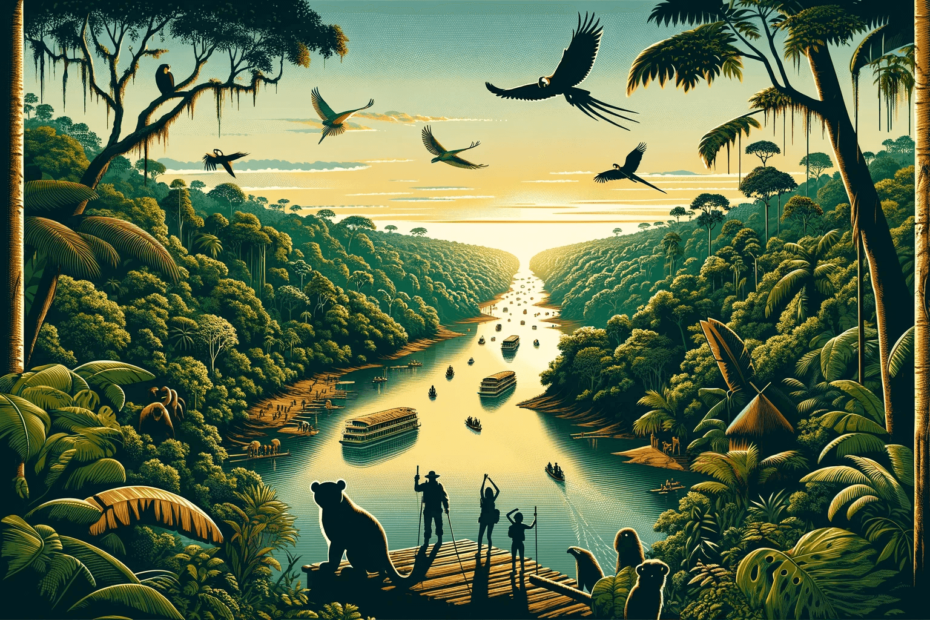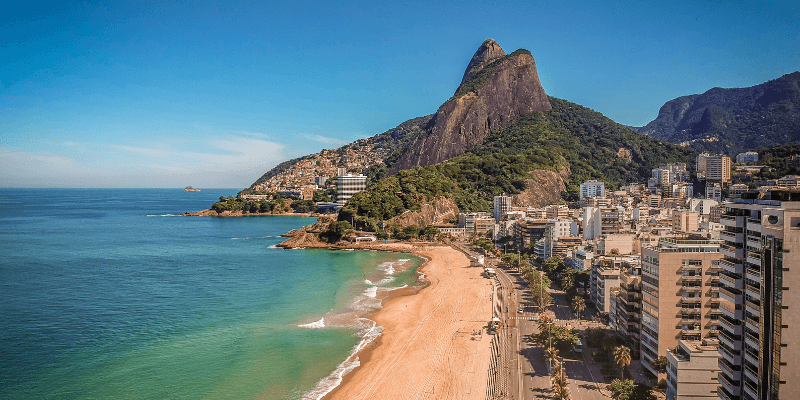- Where is the Amazon Rainforest in Brazil? | The Amazon Rainforest in Brazil spans across Acre, Amazonas, Amapá, Pará, Rondônia, Roraima, and parts of Maranhão, Tocantins, and Mato Grosso.
- Key cities for Amazon exploration include: Manaus, Belém, Santarém, Tefé, Altamira, Porto Velho, Macapá, and Boa Vista.
- The best places to see the Amazon vary, with Manaus being a prime starting point for many due to its accessibility and range of experiences.
- The Amazon spans nine countries, with Brazil holding the largest portion.
- Visiting the Amazon Rainforest in Brazil is highly recommended, with considerations for the best time to visit, key locations, and activities.
- Safety in the Amazon involves health precautions, safety tips, environmental considerations, and respecting indigenous communities.
- Manaus is worth visiting for its unique blend of urban culture and natural beauty, serving as the gateway to the Amazon Rainforest.
- The cost of visiting the Amazon can vary widely, from budget-friendly options to luxury experiences.
From the vibrant ecosystems to cultural encounters, discover what makes the Amazon in Brazil a must-visit for adventurers and eco-travelers alike.
Dive into the essence of the Amazon, exploring its significance, accessibility, and the unforgettable experiences it offers.
Where is the Amazon rainforest in Brazil?
The Amazon Rainforest in Brazil stretches across several states, enveloping a significant portion of the country’s northern region. It spans Acre, Amazonas, Amapá, Pará, Rondônia, Roraima, and parts of Maranhão, Tocantins, and Mato Grosso.
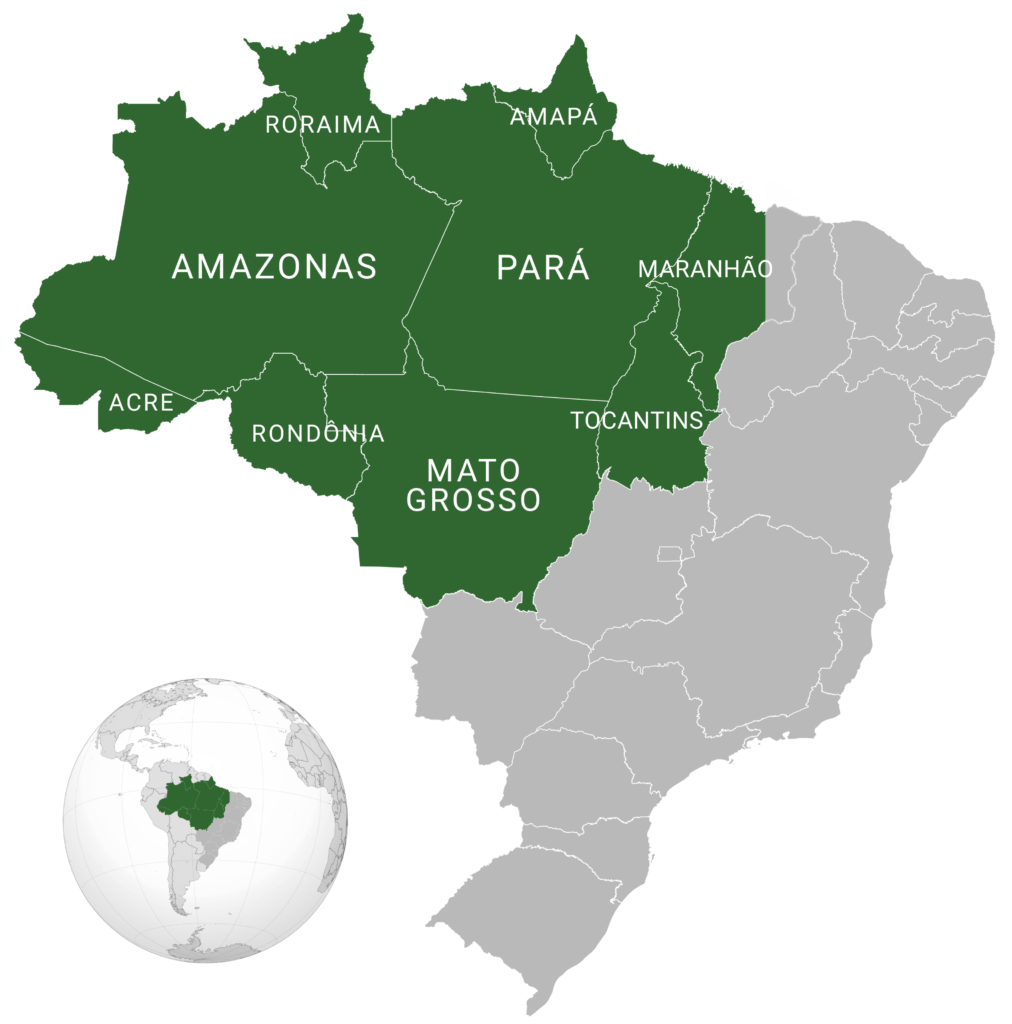
This immense jungle, teeming with biodiversity, is not just the lung of our planet but also a treasure trove of ecological wonders, deeply intertwined with the cultural heritage and identity of Brazil.
Plan your trip to Brazil
- Find the cheapest flights
- Discover the best accommodation
- Explore this incredible country with the best experiences
- Stay connected at all times with an eSIM
What city in Brazil has the Amazon rainforest?
Manaus, the capital of Amazonas, is the most notable city within the Amazon rainforest in Brazil.
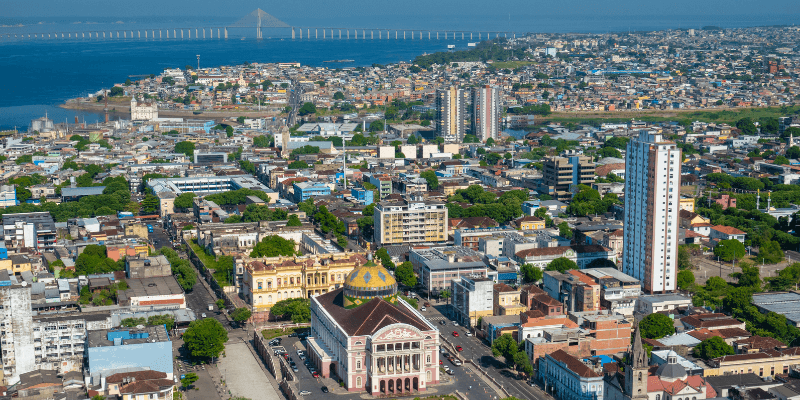
Situated in the heart of the jungle, Manaus serves as a gateway to exploring the vast and biodiverse Amazon.
It’s a vibrant hub of culture, history, and a starting point for river cruises and jungle treks, offering visitors a unique blend of urban life amidst one of the world’s most important natural habitats.
Beyond Manaus, several other cities in the Brazilian Amazon offer unique experiences and gateways to the rainforest:
- Belém – The capital of Pará, known as the gateway to the Amazon River, with vibrant markets and colonial architecture.
- Santarém – Where the Tapajós and Amazon Rivers meet, offering stunning river beaches and access to the Tapajós National Forest.
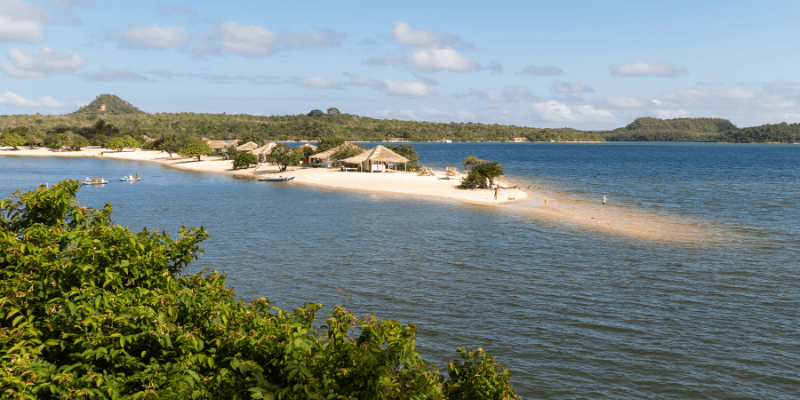
- Tefé – Near the Mamirauá Sustainable Development Reserve, a pioneering project in community-based conservation.
- Altamira – Close to the Xingu River, offering access to traditional indigenous communities and the Belo Monte Dam.
- Porto Velho – The capital of Rondônia, a starting point for journeys along the Madeira River, one of the Amazon’s major tributaries.
- Macapá – Located on the Amazon Delta, unique for being cut by the Equator line and its proximity to the untouched Tumucumaque Mountains National Park.
- Boa Vista – The capital of Roraima, offering a mix of rainforest and savannah landscapes, and a gateway to Mount Roraima.
Also See | 22 Must-Know Animals From Brazil Amazon Rainforest
Where is the best place to see the Amazon in Brazil?
Determining the “best” place to see the Amazon in Brazil largely depends on what you’re looking to experience.
However, Manaus stands out as a prime starting point for many adventurers and nature lovers due to its accessibility and the wealth of experiences it offers.
From Manaus, you can easily arrange tours that take you deep into the heart of the Amazon Rainforest, allowing for an immersive experience of its diverse ecosystems, wildlife, and the unique cultures of its indigenous peoples.
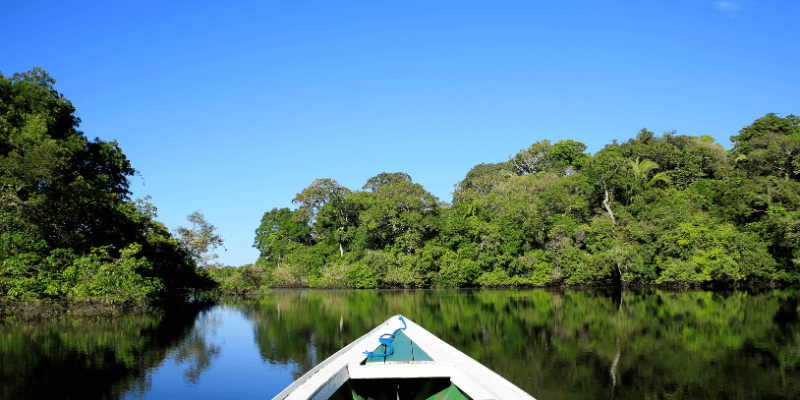
For those interested in biodiversity and eco-tourism, the Mamirauá Sustainable Development Reserve near Tefé offers a unique opportunity to see conservation efforts in action, with chances to spot a variety of wildlife in their natural habitat, including the elusive jaguar and the unique Uakari monkeys.
Another exceptional area is the meeting of the waters, where the dark waters of the Rio Negro meet the sandy-colored Amazon River near Manaus.
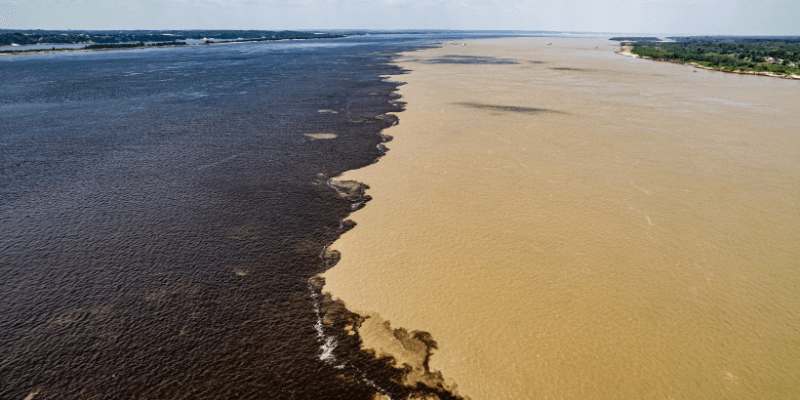
This natural spectacle is a visual representation of the Amazon’s vast ecological diversity.
Whether it’s through a guided jungle trek, a riverboat cruise, or a stay in an eco-lodge, the Amazon has a way of captivating hearts with its indomitable spirit and breathtaking beauty.
Where are the Amazon rainforest located?
The Amazon Rainforest, often referred to as the “lungs of the Earth,” spans across nine countries in South America. Its vast expanse includes:
- Brazil – The largest portion of the rainforest is located here, comprising about 60% of the Amazon.
- Peru – Holding the second-largest portion, with about 13% of the rainforest.
- Colombia – Home to around 10% of the Amazon.
- Venezuela
- Ecuador
- Bolivia
- Guyana
- Suriname
- French Guiana (an overseas department of France)
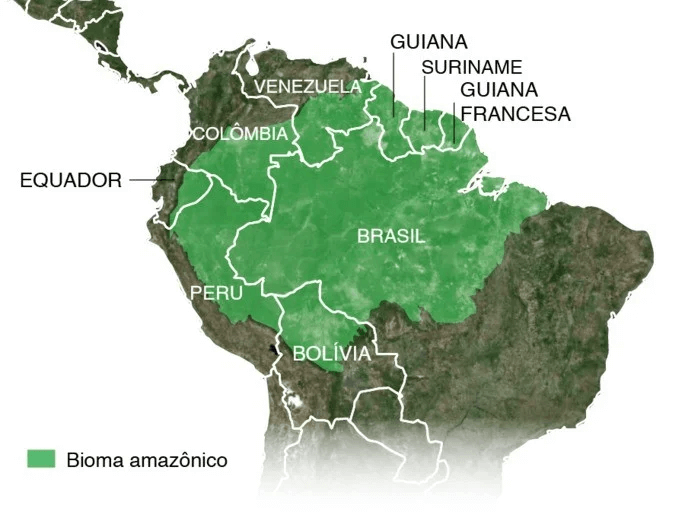
This immense jungle stretches over 5.5 million square kilometers (2.1 million square miles) and is the most biodiverse rainforest on the planet, harboring millions of species of flora and fauna, many of which are yet to be discovered.
It plays a crucial role in regulating the world’s oxygen and carbon cycles, making its conservation vital for global climate stability.
Can I visit the Amazon rainforest in Brazil?
Yes, you can visit the Amazon Rainforest in Brazil, and it’s a highly recommended experience for nature lovers, adventure seekers, and those looking to immerse themselves in one of the planet’s most vital and vibrant ecosystems.
Here are a few tips and considerations for planning your visit:
Best Time to Visit
- Dry Season (June to November): Ideal for hiking and exploring the forest, as trails are more accessible and the risk of floods is lower.
- Wet Season (December to May): Rivers are higher, allowing deeper exploration by boat, and the rainforest is lush and vibrant. However, expect heavy rains and more mosquitoes.
Key Locations
- Manaus: The capital of Amazonas state, serving as the primary gateway to the Amazon. From here, you can join various tours, ranging from day trips to longer expeditions into the heart of the rainforest.
- Tefé: Near the Mamirauá Sustainable Development Reserve, offering unique eco-tourism experiences and wildlife viewing.
- Alter do Chão: Known as the “Caribbean of the Amazon,” located near Santarém, offers beautiful freshwater beaches and clear rivers.
Things to Do
- River Cruises: A popular way to see the Amazon, ranging from luxury ships to more basic riverboats.
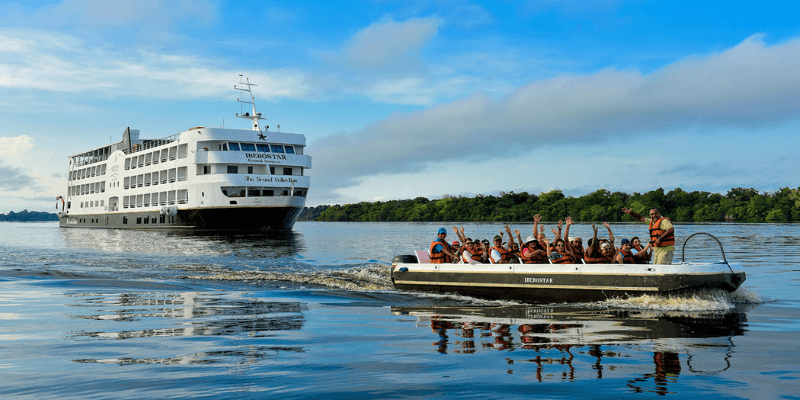
- Jungle Lodges: Stay in the heart of the Amazon, with guided tours and activities like wildlife spotting, fishing for piranhas, and visiting indigenous communities.
One of the best-rated options is the Juma Amazon Lodges, located about 3 hours from Manaus.
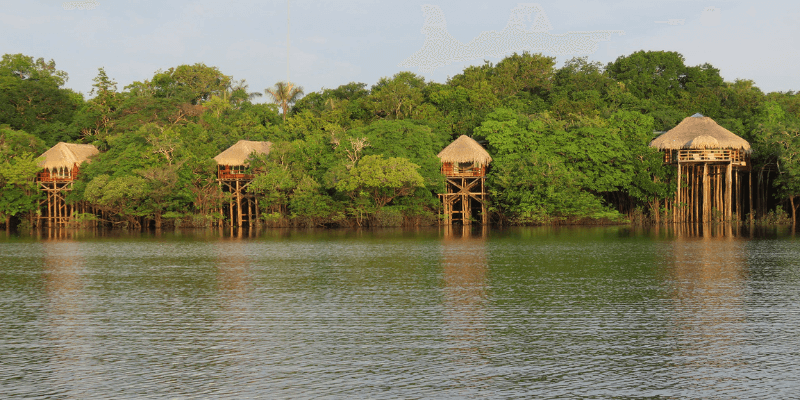
- Eco-Tours: Participate in conservation-focused tours, learn about the biodiversity of the region, and the cultural heritage of its indigenous peoples.
Discover the best value accommodation in Manaus
Travel Tips
- Vaccinations: Ensure you’re up to date on vaccinations, including yellow fever. Malaria prophylaxis is also recommended.
- Guides: To maximize your experience and ensure safety, opt for tours with knowledgeable local guides.
- Respect the Environment: The Amazon is a delicate ecosystem. Follow guidelines to minimize your impact, such as not disturbing wildlife and disposing of waste properly.
Also See | Discover the 5 largest Amazon Rainforest Tribes and other information about all the peoples who live in the forest
Is it safe to visit the Amazon rainforest?
Visiting the Amazon Rainforest can be a safe and incredibly rewarding experience with the right preparations and precautions.
Here are some key considerations to ensure your trip is both enjoyable and safe:
Health Precautions
- Vaccinations: Ensure you’re vaccinated against Yellow Fever, and consider vaccines for Typhoid, Hepatitis A and B, and other region-specific diseases as recommended by health authorities.
- Malaria and Dengue Fever: Use mosquito repellent, wear long-sleeved clothing, and sleep under a mosquito net if staying in areas prone to these diseases. Prophylactics for malaria might be recommended based on your travel plans.
- Stay Hydrated and Eat Safely: Drink bottled or purified water and be cautious about food hygiene to avoid waterborne illnesses.
Safety Tips
- Hire Experienced Guides: Always opt for tours with reputable and experienced guides familiar with the local environment and potential hazards.
- Wildlife Encounters: The Amazon is home to many species that can be dangerous if provoked or startled. Listen to your guide’s advice on how to behave around wildlife.
- Personal Safety: As with any travel destination, be mindful of your personal belongings and aware of your surroundings, especially in urban areas near the Amazon.
Environmental Considerations
- Respect Nature: The Amazon’s ecosystem is delicate. Follow all guidelines regarding waste disposal, interactions with wildlife, and plant life preservation.
- Be Prepared for the Climate: The Amazon is hot, humid, and rainy. Pack appropriate clothing, waterproof gear, and consider the physical demands of any tours or hikes.
Legal and Ethical Considerations
- Respect Indigenous Communities: Some areas of the Amazon are home to indigenous peoples. Tours that involve visiting these communities should be respectful and conducted in a way that doesn’t exploit or harm their way of life.
- Support Sustainable Tourism: Choose operators and activities that support conservation efforts and contribute positively to the local economy without harming the environment.
Is it worth visiting Manaus Brazil?
Visiting Manaus, Brazil, is indeed worth it, especially for those intrigued by the unique blend of urban culture and natural beauty.
As the gateway to the Amazon Rainforest, Manaus offers a fascinating mix of experiences that cater to both adventurous spirits and those looking to delve into the cultural richness of the region.
Here’s why Manaus is a destination worth considering:
Connection to the Amazon Rainforest
- Proximity to Nature: Manaus is an excellent base for exploring the Amazon Rainforest, with numerous tour operators offering trips into the jungle, river cruises, and visits to indigenous communities.
- Meeting of the Waters: Witness the spectacular natural phenomenon where the dark waters of the Rio Negro meet the sandy-colored Amazon River, flowing side by side without mixing for several miles.
Cultural Experiences
- Teatro Amazonas: The iconic opera house in the heart of Manaus is a testament to the city’s rich history during the rubber boom. It hosts a variety of performances and is open for tours.
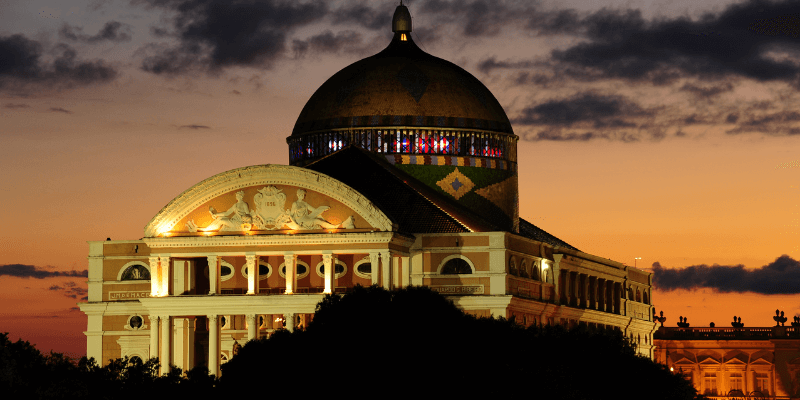
- Mercado Adolpho Lisboa: Manaus’ main market offers a glimpse into local life, with stalls selling everything from Amazonian fruits to crafts and spices.
- Indigenous Culture: There are opportunities to learn about the indigenous peoples of the Amazon, their history, and their current way of life, through museum exhibits and cultural centers.
Culinary Delights
- Amazonian Cuisine: Manaus is a great place to try dishes unique to the Amazon region, including fish like pirarucu and tambaqui, fruits like cupuaçu and açaí, and other local ingredients that provide a taste of the jungle.
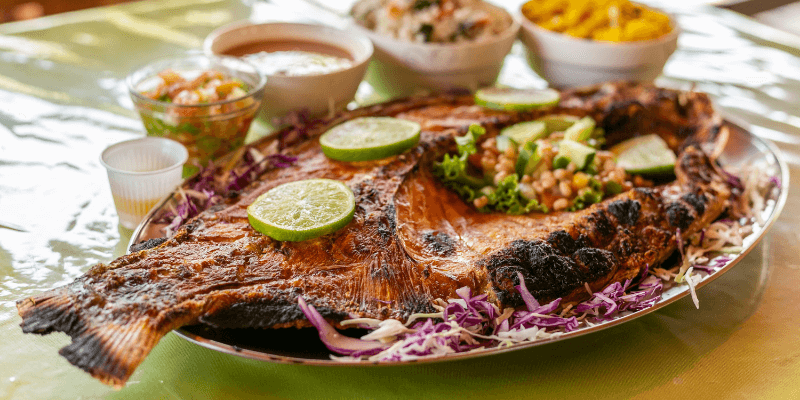
Also See | Food In Brazil: A Journey Through 31 Dishes
Adventure and Activities
- Eco-tourism and Adventure Sports: Beyond jungle tours, Manaus offers fishing, bird watching, and even swimming with pink dolphins. The surrounding areas provide ample opportunities for eco-tourism and adventure activities.
Accessibility
- Gateway to the Amazon: Manaus is well-connected by air with flights from major Brazilian cities and some international destinations, making it an accessible starting point for Amazonian adventures.
Visiting Manaus allows travelers to immerse themselves in the heart of the Amazon, experiencing its natural wonders and cultural heritage firsthand.
How much does it cost to visit the Amazon rainforest?
- Budget Travelers: Could manage on as little as $50 to $100 per day if sticking to basic accommodations and self-guided activities.
- Mid-Range: For a comfortable experience with guided tours and nicer accommodation, $100 to $400 per day.
- Luxury: For an all-inclusive, high-end experience, $400 to $800+ per day.
The cost of visiting the Brazilian Amazon Rainforest can vary widely depending on several factors such as the length of your trip, the type of accommodation, the activities you plan to do, and how you choose to travel.
Here’s a breakdown to give you a general idea of the potential costs:
Travel Expenses
- Flights: Airfare to get to the Amazon region, particularly to cities like Manaus or Belém in Brazil, will vary greatly depending on your starting point and the time of year. International flights can range from a few hundred to over a thousand dollars.
- Local Transportation: Costs for getting around locally, including airport transfers, boat rides, and any other ground transportation.
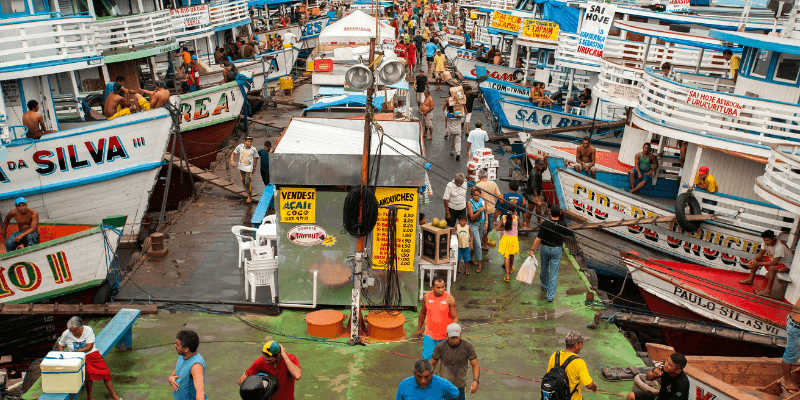
- Prices can vary from a few dollars for local transport to several hundred dollars for private transfers or charter flights to more remote areas.
Accommodation
- Budget Options: Hostels and budget hotels can range from $20 to $50 per night.
- Mid-Range: Comfortable hotels or eco-lodges might cost between $50 to $200 per night, depending on the location and amenities.
- Luxury: High-end lodges and cruises can cost anywhere from $200 to over $500 per night, offering all-inclusive experiences with guided tours and gourmet meals.
Tours and Activities
- Day Trips: Simple day trips into the rainforest can start at around $50 to $100.
- Multi-Day Tours: Packages for multi-day tours, including accommodation, meals, and guided excursions, can range from $200 to $500 per day, depending on the level of luxury and the activities included.
- Specialized Activities: Special tours like fishing expeditions, bird watching, or visits to indigenous communities can add to the cost, ranging from $100 to several hundred dollars extra.
Miscellaneous
- Meals and Drinks: Costs will vary greatly depending on where you eat and what you choose to do. Street food and local markets can be very cheap, while dining at tourist-oriented or high-end restaurants will be more expensive.
- Equipment and Gear: Depending on what you already have, you may need to budget for appropriate clothing, gear, and any vaccinations or medical precautions recommended for the area.
Embracing the Amazon’s Majesty
The Amazon Rainforest in Brazil is a realm of unparalleled biodiversity and cultural depth, sprawling across numerous states and offering a mosaic of experiences from Manaus to Boa Vista.
As the world’s largest rainforest, it not only captivates with its ecological wonders but also with the rich tapestry of communities and cultures within.
Whether seeking adventure, connection with nature, or cultural immersion, the Amazon beckons with open arms.
Embracing its majesty means respecting its ecosystems, peoples, and the sheer scale of experiences it offers, from the budget-conscious to the luxury seeker.
The journey into the Amazon is not just a visit; it’s a profound encounter with the heart of our planet.
Did you like our content, do you want to get to know our country?! Discover the best experiences to live in Brazil!
